SPAIN: The production of Iberico ham is at risk as droughts in the Spanish region of Extremadura have vastly impacted the pig’s diet.
The popular dry-cured ham is made by blackfoot pigs that eat acorns in oak and cork tree groves found in the west and north-west of Spain.
The jamon is produced in the most undeveloped, poorest regions of Spain and is therefore essential for the small economies that thrive on it.
The high temperatures, coupled with the unusually hot and dry summers, result in fewer acorns being produced by the oaks.
Due to this and the decrease in the market price, there was a twenty percent reduction in jamon iberico production last year in Extremadura.
The pigs are taking a longer time to reach the ideal weight, delaying the production of the ham.
2022 witnessed the hottest climate recorded and the third driest, with the rainfall decreasing by approximately 35% in the past 50 years.
The fattening period for the Iberian pigs is called “La Monetanera,” during which the pigs spend time in pastures as they graze and eat acorns, increasing weight in a couple of months from October to March, after which they are slaughtered.
The Interprofessional Association of the Iberian Pigs (ASICI) have suggested that in this “montanera,” between 15 and 20 percent fewer acorn-fed pigs will be slaughtered than in the 2021–22 session. If this continues, then the Iberico ham is bound to be scarcer and more expensive in the next four years.
Rodrigo Cardeno Sanchez, the owner of a farm in Badajoz, Extremadura, says: “Obviously the production of grass and acorns has been much less this year,” adding, “We are talking about an animal that should start October weighing 90 kilogrammes and end January at approximately 150 or 140 kilograms.”
The manager of the cured meat company Iluion Ibericos de Azuaga, Emilio Munoz, confesses that there is a shortage of 2,000 to 3,000 pigs this season.
He says, “We have cut 15-20 percent of what we had planned. “Expenditure has reached the same level as income, and it’s a disaster.”
Some farmers have already increased the boundaries of the lands they are using and have slaughtered the hams before the full weight is reached in order to ensure production. The increase in production costs would reduce the profitability of these farmers.
Also Read: Economic Survey 2023: FDI Equity Inflows Fell Due to Russia-Ukraine Conflict



